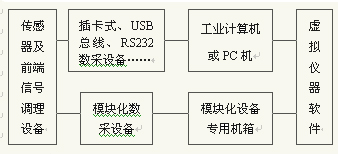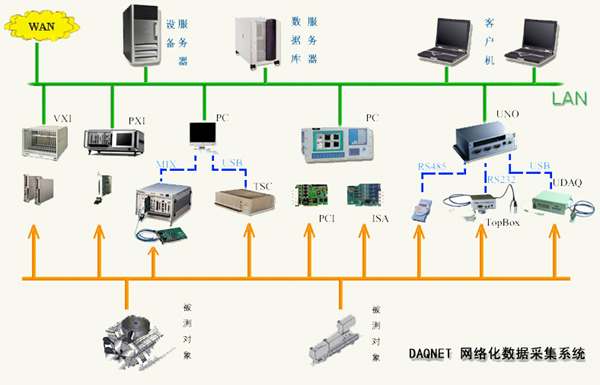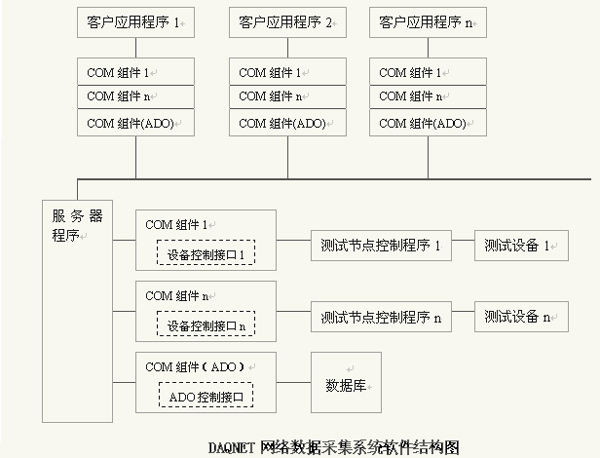The network of measurement and control instruments and meters has become the direction of development in the field of measurement and control, and instrument and meter standards are constantly moving closer to computer standards and network specifications. The networked monitoring and control technology mainly promotes the development of the measurement and control instrumentation from the following three aspects: it reduces the cost of the test system; it is easy to remotely measure and control and share resources; it is easy to maintain and use remote diagnostics and test equipment. Today, networked data acquisition systems have been used in many fields such as manufacturing, engineering sites, and scientific research experiments, and customers are increasingly demanding the establishment of large-scale, complex, and networked test system solutions. Second, the traditional data acquisition system ☆ Composed of plug-in card, modular or USB bus data acquisition equipment and corresponding hardware platform, coupled with front-end sensor equipment, under the control of the virtual instrument software, to complete the function of localized data collection. * The function is clear and single, and the data collection and corresponding post-processing are completed directly in the local area, which can meet the test requirements of small scale. III. Networked Data Acquisition System ☆ Introduction In a large-scale, complex test system, system equipment such as conditioning, input, output, and result analysis are often distributed in different locations. Using only one device does not complete the entire test task, but needs to be distributed in different geographical locations. Multiple devices work together. With the development of computer network technology, bus technology and database technology, a new solution has matured for the needs of a large-scale and complex test system. This is a networked data acquisition system. ☆ Composed of traditional data acquisition system technology, using computer network technology and bus technology to integrate test equipment distributed in different geographical locations and different functions together with servers, clients, and databases to form a measurement and control LAN system through networking. The virtual instrument software realizes a variety of measurement and control functions that are complex and mutually combined. ☆ Features Combine the card-type, modular or USB bus data acquisition equipment with the corresponding hardware platform, coupled with the front-end sensor equipment, and complete the localized data collection function under the control of the virtual instrument software. Four TDEC Networked Data Acquisition System ☆ Hardware System Platform * Combine all kinds of data acquisition equipments independently produced by TDEC, use computer network technology, bus technology, plus server, client, and database platforms to form a measurement and control LAN system. Under the control of networked virtual instrument software, implement together. Complex, combined with a variety of monitoring and control functions. * Test Node Among them, each test node can use different series of data acquisition equipment of TDEC for different customer needs. On each test node, the system provides a complete control of the device. * The composition adopts the C/S mode architecture and is an open system collaborative processing mode. The core technology is COM component technology. ☆ System Features V. Application areas JIANGYANG Special Cables are shipboard wire, diesel engine dedicated cable, sensor dedicated cable, profibus cable, solid PE insulated radio frequency cable with solid PE dielectric, coaxial cable with physical-foamed polyethylene insulation used in CATV systems, RG Serials polyethylene insulation coaxial cable, muticore and symmetrical pair/quad cable for digital communications horizontal floor wiring-solid polyethylene insulate. Wire Cable,Special Cable,Tinned Copper Wire,Flame Retardant Shipboard Flexible Wire Jiangsu Jiangyang Special Cable Co,.Ltd. , https://www.jymarinecable.com
TDEC combines its own product features, through continuous exploration and practice, can provide a complete network-based data acquisition system solution based on TDEC data acquisition equipment, and has been successfully used in engineering projects.
☆ Extension Structure ☆ Features
* High requirements for test site performance, ranging from the front-end sensor equipment to the hardware platform of the data acquisition system to the operator controlling the virtual instrument software.
* The acquisition system lacks network functions and poor scalability. It is difficult or impossible to meet changes in user requirements and parallel acquisition of large amounts of data (such as hundreds of channels).
* The establishment of a large-scale system with many measurement signals and a wide range of distribution, using traditional technology, can only be solved by investing a large amount of costs, increasing system equipment and testing personnel; in the course of daily use and maintenance, it will also consume more resources. 
* Has the same architecture and communication model as LAN.
* Distributed measurement, centralized management, diversification of system functions, user-friendly interface, and control of network test equipment are as convenient as the operation of local equipment.
* Virtual instruments, oscilloscopes, logic analyzers, PCs, IPCs, and various intelligent measurement and control instruments can all become nodes in the measurement and control network.
* Relatively low cost of establishment, use, and maintenance compared to conventional test systems of the same size.
* Easy remote monitoring and resource sharing.
* Easy to test equipment for remote diagnosis and maintenance.
* System integration signal acquisition, data processing, data storage, data transmission and control and other processes.
* Structure 
* The server server implements the management of test equipment on all test nodes. At the same time, the server also manages client privileges and database services.
* The client client is a window for the user to operate and control the entire system. Under the management of the server, the networked virtual instrument software can be used to control the corresponding test node; the test data is analyzed and processed according to the system requirements; The database information is queried and managed.
* After the database database is configured and managed by the server, it can provide clients with various data storage services. Can also be based on the needs of the system to publish the corresponding data to the LAN and even WAN for users to query.
☆ Software Technology Implementation
* Structure 
* The underlying program runs the control program of the corresponding test equipment at each test node, and can realize all program control operations of the TDEC acquisition equipment. The database control program uses ADO (ActiveX Data Object) technology. ADO is an object-oriented database development technology. It uses high-level access technology to access the encapsulated COM interface in OLE DB to access the database.
* The server program server program is responsible for the management of numerous devices in the system and the dispatch work of the client for device operation requests.
* The client application client application uses a user-friendly graphical interface. An operator can control and operate all test nodes in the network on one client, and obtain test data and data post-processing. Different applications use different client applications.
* COM components The above three-layer modules are independent and can be linked through COM component technology. You can encapsulate the interfaces provided by the underlying program into COM components; these components are configured on test nodes, servers, and clients. Based on the distributed nature of DCOM, all protocols of the computer network can be bypassed and the transmission of network data can be realized directly.
* System-scale self-adaptation achieves the purpose of distributed measurement, centralized control and management testing. At the same time, it can flexibly build and customize the number and scale of equipment according to application needs, and system software automatically adapts.
* Strong system function A variety of TDEC equipments can be used in the system. At the same time, the functions of different equipments can be combined to realize the diversified functions of the system.
* High stability of the system adopts a modular layered design and introduces more advanced COM component technology to easily implement network data transmission.
* Low cost enables expensive hardware devices and software to be shared within the network, reducing equipment reinvestment. At the same time, it also saves human resources. In the daily use and maintenance process, only a small number of operators are required.
* Extensive system modules are independent and easy to expand. Just add the appropriate control program to add hardware devices.
* Online monitoring in industrial manufacturing and automation
* Various complex dynamic and static parameter measurements in wind tunnel tests
* Large-scale test occasions for measurement and control of multiple devices: nuclear detonation, space launch, etc.
* Comprehensive test system for power production and operation
* Multi-client real-time monitoring, query application of test data
* Teaching applications
I. Overview